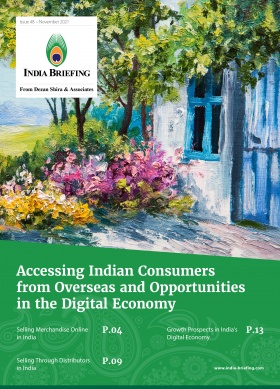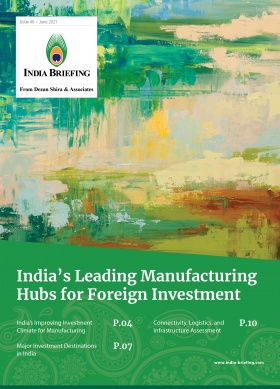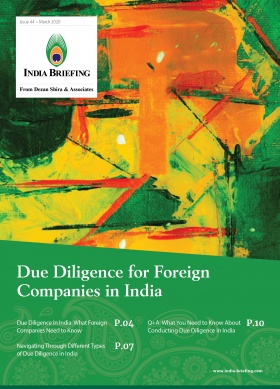An Introduction to Doing Business in India 2022 – New Publication from Dezan Shira & Associates
An Introduction to Doing Business in India 2022, the latest publication from Dezan Shira & Associates, is out now and available as a complimentary download on the Asia Briefing Publication Store.
2021 saw India successfully steer its economy into recovery mode despite major pandemic outbreaks in the first half of the year. Containment strategies are now the new normal alongside a national vaccination program. In 2022, more vaccines are expected to become available as well as guidelines for vaccine booster shots and a legal framework for work-from-home to define the liability of employers towards employees. International travel is yet to return to normal and air bubble arrangements will continue for the foreseeable future.
Living with COVID-19 is now a strategy for most countries, including India. This is necessary to curb slowdowns, facilitate economic activity, and resuscitate consumption growth after an extended period of uncertainty. However, this strategy will almost certainly be accompanied by technology disruption in every sector of the economy – creating opportunities for new corporate verticals, R&D, and start-ups besides triggering major changes in human resource management.
Amid this state of disruption and global economic volatility, India is pushing ahead with its intention to expand the contribution of its manufacturing sector to the GDP. The goal for the Modi government is to narrow existing gaps in local supply chains and bolster production capacity in critical areas of the new economy. In turn, this will also enhance India’s export-oriented manufacturing potential, establish the country’s higher value in the global supply chain, and lower sector-wise import dependencies.
WEBINAR – Looking Ahead to 2022: Doing Business in India (January 19, 2022)
2:30 PM India Time / 4:00 PM Vietnam Time / 5:00 PM China Time
Join our India investment experts, Sunny Makhija, International Business Advisory Assistant Manager, and Radhika Gupta, International Business Advisory Junior Associate, as they share updates on India’s improving business environment and the increasing scope of opportunities it offers to foreign investors. You’ll also learn about the major incentives and reforms that will push India to becoming the fastest growing major economy in the world in 2022.
This webinar is FREE of charge.
So far 13 sectors have been identified for Production-Linked Incentives (PLI) schemes and its beneficiaries need to meet certain targets, such as initial and planned investments, innovation, and sales, over a specified period. These 13 sectors should be attractive for foreign investment as they will require infrastructure upgrades, advanced production knowhow, R&D, logistics support, among others. They will also benefit from a liberal investment environment. More likely as well is that industries in these sectors will become more organized, benefit from regulatory reforms, and strengthen corporate governance standards.
For example, in 2022, the healthcare sector is looking to be highly attractive: multiple PLI programs intend to build up critical industry capacity for production of medical devices and bulk drugs and major players across manufacturing, hospital, health insurance, and healthtech segments are poised to consolidate their presence / go public / integrate their business offerings. COVID has introduced special circumstances, which brings together opportunities for India to step up its domestic market appeal, magnify export capabilities, and lay the foundations for a stronger health tourism ecosystem.
Besides healthcare, high-tech innovation will continue to be prioritized and witness investor interest. Whether it is to supplement offline businesses, cater to climate change mitigation efforts, or facilitate sector-wise infrastructure upgrades – technology (software, hardware, R&D) production and services will be a target for government incentives and corporate investment.
Major industries set to benefit from this tech-pivot include telecommunications, electric vehicles and advanced auto components, logistics, financial services, and agritech. Against this background, it is unsurprising that the Indian government is also doubling down on its efforts to make the semiconductor industry an attractive proposition for foreign investors. Chips are integral to the Indian economy’s appetite for electronic and IoT devices, but also core production sectors like automotive.
The Indian government is offering a mix of incentives to the semiconductor industry – scheme-based and integrated in respective PLI/industry promotion programs – to establish a design, R&D, and production base in the country from the ground up. India is also seeking a trade deal with Taiwan, whose semiconductor companies are at the frontier of the sector globally.
Overall, 2022 will continue to see India roll-out reforms to streamline bureaucratic processes, ease doing business, and digitize government interface to facilitate greater foreign investment and trade. India aims to achieve an export shipment target of US$450-$500 billion by FY22, up from US$291 billion in FY21. Consequently, early harvest deals and full FTAs will assume newfound importance to an otherwise trade conservative regime.
Designed to introduce the fundamentals of investing in India, An Introduction to Doing Business in India 2022 is compiled by the experts at Dezan Shira & Associates, a specialist practice providing corporate establishment, business advisory, tax advisory and compliance, accounting, payroll, due diligence, and financial review services to multinationals investing in emerging Asia.
Doing Business in India 2022 covers the following:
- Corporate Establishment
- India’s Investment Climate
- Tax, Audit, and Accounting
- Human Resources and Payroll
Within these chapters, we discuss a range of different topics that affect doing business in India, including market entry considerations, investment models, key taxes applicable for foreign companies, and impending legal reforms.
Special focus is given to the 13 sector-specific PLI schemes and their expected impact on production investments in the country. Where applicable, the guide lists out the approved PLI beneficiaries under the respective sectors – information that will be of value to foreign companies planning an entry into the Indian market or keen to diversify their supply chain exposure.
About Us
India Briefing is produced by Dezan Shira & Associates. The firm assists foreign investors throughout Asia from offices across the world, including in Delhi and Mumbai. Readers may write to india@dezshira.com for more support on doing business in in India.
We also maintain offices or have alliance partners assisting foreign investors in Indonesia, Singapore, Vietnam, Philippines, Malaysia, Thailand, Italy, Germany, and the United States, in addition to practices in Bangladesh and Russia.
- Previous Article India-South Korea Trade and Investment: Trends and Opportunities
- Next Article Sectors Expected to Dominate India’s Investment Scenario in 2022 and Enabling Economic Policies









